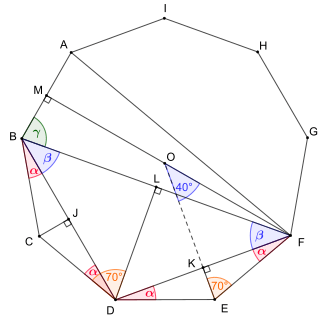Morrie's law
Morrie's law is a special trigonometric identity. Its name is due to the physicist Richard Feynman, who used to refer to the identity under that name. Feynman picked that name because he learned it during his childhood from a boy with the name Morrie Jacobs and afterwards remembered it for all of his life.[1]
Identity and generalisation
It is a special case of the more general identity
with n = 3 and α = 20° and the fact that
since
Similar identities
A similar identity for the sine function also holds:
Moreover, dividing the second identity by the first, the following identity is evident:
Proof
Geometric proof of Morrie's law

Consider a regular nonagon with side length and let be the midpoint of , the midpoint and the midpoint of . The inner angles of the nonagon equal and furthermore , and (see graphic). Applying the cosinus definition in the right angle triangles , and then yields the proof for Morrie's law:[2]
Algebraic proof of the generalised identity
Recall the double angle formula for the sine function
Solve for
It follows that:
Multiplying all of these expressions together yields:
The intermediate numerators and denominators cancel leaving only the first denominator, a power of 2 and the final numerator. Note that there are n terms in both sides of the expression. Thus,
which is equivalent to the generalization of Morrie's law.
References
- W. A. Beyer, J. D. Louck, and D. Zeilberger, A Generalization of a Curiosity that Feynman Remembered All His Life, Math. Mag. 69, 43–44, 1996. (JSTOR)
- Samuel G. Moreno, Esther M. García-Caballero: "'A Geometric Proof of Morrie's Law". In: American Mathemtical Montly, vol. 122, no. 2 (February 2015), p. 168 (JSTOR)
Further reading
- Glen Van Brummelen: Trigonometry: A Very Short Introduction. Oxford University Press, 2020, ISBN 9780192545466, pp. 79-83
- Ernest C. Anderson: Morrie's Law and Experimental Mathematics. In: Journal of recreational mathematics, 1998